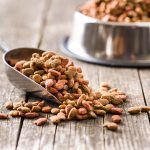Choosing the right pet food is essential for your pet’s health and well-being. With so many options available, it can be challenging to determine which food is the best for your furry friend. Here are some tips to help you select the healthiest pet food:
Understand Your Pet’s Nutritional Needs
Different pets have different dietary requirements. Factors such as age, breed, size, and activity level influence their nutritional needs. Consult with your veterinarian to understand the specific nutritional requirements for your pet
Read the Ingredients List
The ingredients list provides valuable information about what’s in the food. Look for high-quality, recognizable ingredients like meat, vegetables, and whole grains. Avoid foods with excessive fillers, artificial preservatives, colors, and flavors.
Check for AAFCO Approval
Ensure the pet food meets the standards set by the Association of American Feed Control Officials (AAFCO). This ensures the food provides complete and balanced nutrition for your pet.
Look for Specific Protein Sources
High-quality pet foods list specific protein sources, such as chicken, beef, or fish, rather than generic terms like “meat” or “meat by-products.” Protein should be one of the main ingredients in your pet’s food.
Consider Grain-Free Options Carefully
Grain-free diets have become popular, but they are not necessary for all pets. Some pets may benefit from grain-free diets, especially if they have specific allergies or sensitivities. Consult with your veterinarian before making this decision.
Evaluate the Food’s Nutritional Profile
Look for a balanced ratio of proteins, fats, and carbohydrates. High-quality pet foods provide all essential nutrients in the right proportions to support your pet’s health.
Research the Brand
Choose reputable brands with a history of producing high-quality pet foods. Research the company’s manufacturing practices, ingredient sourcing, and quality control measures. Customer reviews and recommendations from veterinarians can also be helpful.
Avoid Artificial Additives
Artificial preservatives, colors, and flavors are unnecessary and can be harmful to your pet. Opt for foods with natural preservatives, such as tocopherols (vitamin E) and ascorbic acid (vitamin C).
Consider Your Pet’s Life Stage
Pets have different nutritional needs at various stages of life. Ensure the food is appropriate for your pet’s life stage, whether they are a puppy/kitten, adult, or senior.
Monitor Your Pet’s Health
Pay attention to how your pet responds to their food. Look for signs of good health, such as a shiny coat, healthy skin, regular bowel movements, and steady energy levels. If you notice any adverse reactions or changes in health, consult your veterinarian.
Choosing the healthiest pet food requires careful consideration and research. By following these tips, you can ensure that your pet receives the nutrition they need to thrive. Always consult with your veterinarian for personalized advice and recommendations tailored to your pet’s unique needs.
The first step toward success is taken when you refuse to be a captive of the environment.
Powerful & Creative
Vestibulum facilisis tincidunt leo quis accumsan. Quisque ornare enim quam, id faucibus mi posuere nec. Fusce at justo ligula. In maximus vitae enim eu tincidunt. Aliquam egestas leo sit amet nunc interdum ornare. In semper, metus non dapibus efficitur, lacus ligula luctus metus, eget posuere arcu leo nec enim. Pellentesque accumsan elementum consequat. Vivamus vehicula tempor leo, ut lacinia metus hendrerit faucibus. Fusce tellus leo, tincidunt quis turpis at, suscipit sagittis lectus.
Suspendisse quis iaculis eros. Orci varius natoque penatibus et magnis dis parturient montes, nascetur ridiculus mus. Donec ac nibh nec leo tincidunt eleifend. Nulla euismod suscipit purus nec faucibus. Nunc efficitur sed nisi eget ultrices. Ut fringilla luctus dolor, eu facilisis magna eleifend nec. Aliquam erat volutpat.









Vestibulum facilisis tincidunt leo quis accumsan. Quisque ornare enim quam, id faucibus mi posuere nec. Fusce at justo ligula.